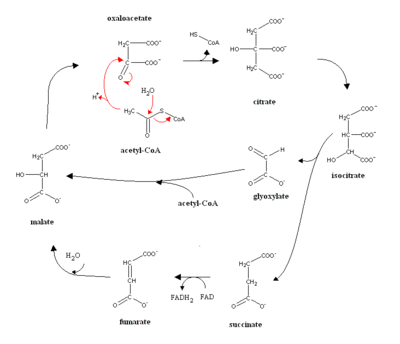Glyoxylate cycle
The glyoxylate cycle is a metabolic pathway occurring in plants and several microorganisms which allows them to use acetyl CoAs for the synthesis of carbohydrates, a task which vertebrates, including humans, cannot perform. The two initial stages of this cycle are identical to those of the citric acid cycle: acetyl-CoA → citrate → isocitrate. The next step, however, is different: isocitrate is cleaved into succinate and glyoxylate (the latter gives the cycle its name). Succinate can be channeled directly into the citric acid cycle and eventually form oxaloacetate. Glyoxylate condenses with acetyl-CoA, yielding malate. Both malate and oxaloacetate can be converted into phosphoenolpyruvate and enter gluconeogenesis. The net result of the glyoxylate cycle is therefore the production of glucose from acetyl CoA.
In plants the glyoxylate cycle occurs in special peroxisomes which are called glyoxysomes. Vertebrates cannot perform the cycle because they lack its two key enzymes: isocitrate lyase and malate synthase.
Attribution
- Some content on this page may previously have appeared on Wikipedia.
Footnotes
